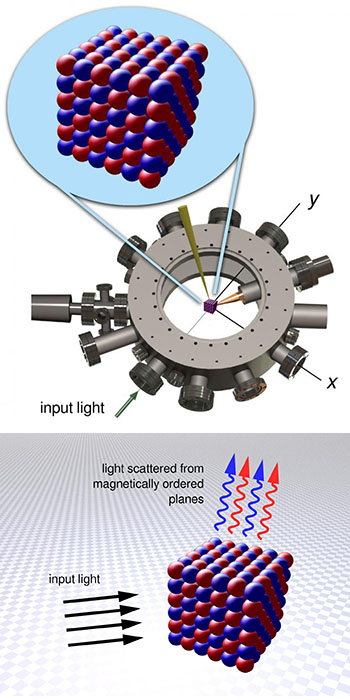
The research team trapped ultracold atoms in an optical lattice of laser beams, to create a model of a crystal lattice (top), and used Bragg scattering to establish the onset of antiferromagnetism in the system (bottom). [Image: P. Duarte/Rice University]
For three decades, scientists have speculated that the physics of high-temperature superconductivity could be explained by the so-called Hubbard model—a set of equations originally developed to describe the properties of electrons in transition metals and their oxides. But a numerical solution to that model eludes even the most powerful computers. Now, a team of U.S. and Brazilian researchers has taken a different tack, using ultracold atoms in a lattice of laser beams to create a physical analog of the mathematical Hubbard model (Nature, doi: 10.1038/nature14223). The laser-lattice model displayed evidence of the antiferromagnetism predicted by the Hubbard model as a superconductivity precursor, which suggests that the system could offer a useful platform for further sussing out the mysteries of high-temperature superconductors.
Developed in the 1960s by John Hubbard, the Hubbard model attempts to describe the magnetic and conduction properties of fermions (such as electrons) in a crystal lattice, taking into account the quantum property of spin. The model has been cited as a promising theory to explain high-temperature superconductivity since the phenomenon’s discovery nearly thirty years ago. But while the model is simple to express mathematically, the solution to Hubbard’s equations is a so-called “NP-hard” problem, meaning that, for realistic systems of more than a few hundred particles, it is effectively unsolvable by digital computers on any practical timescale.
With a digital solution effectively out of reach, the research team, led by Randall Hulet of Rice University (USA), approached the problem from the analog side. Using a recently developed technique, the scientists created a “compensated optical lattice,” loading atoms in a Fermi gas into individual sites in an optical lattice of laser light, and then evaporatively cooling the atoms in place within the lattice. (Conventionally in such experiments, the atoms are cooled first and then loaded into the lattice.) The technique, according to the scientists, allowed the atoms to reach temperatures approximately half those of previous experiments.
The result was an optical lattice with nearly 100,000 sites, in which the laser beams acted as an analog of the Hubbard model’s crystal lattice and the individual supercooled fermionic atoms as analogs of electrons. The team then trained lasers of a carefully calibrated frequency on the model system and measured the Bragg scattering from the sample. The results showed the existence of symmetry planes consistent with the onset of antiferromagnetism in the model system—a key precursor of high-temperature superconductivity that’s embodied in Hubbard’s equations.
“We were able to produce antiferromagnetism in exactly the way the Hubbard model predicts,” said Hulet. “That’s exciting, because it's the first ultracold atomic system that's able to probe the Hubbard model in this way.” The next steps, according to Hulet, will be to push the temperature ranges of the compensated optical lattice system lower, and the measurement techniques further. That, in turn, could enable a deeper exploration of high-temperature superconductivity, including the correlated electron behavior that gives rise to the phenomenon.
